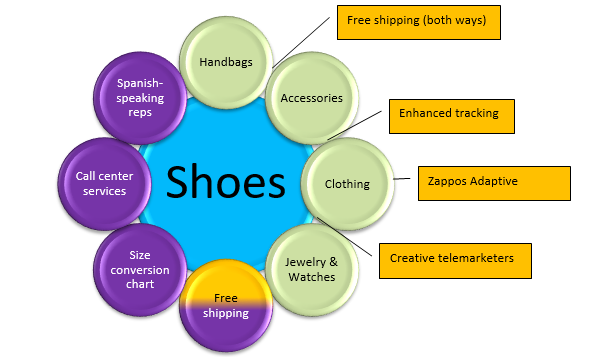
The primary product Zappos offers is footwear although the company is constantly increasing its range of products (see figure 1). The peripheral goods and services are not essential, but they enhance the primary product and add value (Collier & Evans, 2016). Zappos provides such peripheral goods as handbags, accessories, jewelry, watches, and clothing. These items are not essential when marketing footwear, but people often try to buy things that match.
Therefore, when a customer buys the shoes of their dream, they want something nice to wear and enhance their appearance. The seller’s peripheral services include call center services, size conversion charts, and Spanish-speaking representatives. Many online retailers offer such services, which adds value and makes customers’ buying experience more enjoyable.
Free shipping can be regarded as both a common peripheral service and a variant. Variants are products or services that are unique and differentiate a company from its competitors (Collier & Evans, 2016). Zappos revolutionized e-commerce in a way since it was the first seller to offer free shipping in both ways, but, now, many online retailers provide such a service. Enhanced tracking features and Zappos Adaptive are also variants that make the organization well-recognized.
However, creative telemarketers are the primary competitive advantage of the company and one of its most valued variants. Zappos employees are encouraged to “wow” customers and are empowered to make decisions (Collier & Evans, 2016, p. 25). Although the company sells goods produced by other manufacturers, Zappos is completely responsible for their quality.
Primary management processes at Zappos involve the delivery of goods, filling orders, and the provision of support through call centers. Therefore, to execute an order, Zappos employees manage these primary processes. The company is famous for its exclusive service and creative approach to developing relationships with customers. Nevertheless, the effective implementation of these functions can hardly be achieved without support management processes that include purchasing goods from manufacturers, managing inventory and warehouses, and acquiring technology.
Zappos has one of the most efficient information systems that ensure proper data flow and management. Customers can track their orders and even learn about the availability of the items they want (Collier & Evans, 2016). Employees receive updates, reports, as well as reminders, that enable them to manage orders properly. Central general management processes necessary to execute an order at Zappos are information systems and human resources. Human resources management is one of the most remarkable aspects of the organization that pays substantial attention to the empowerment of its employees (Warrick, Milliman, & Ferguson, 2016). Employees are encouraged and trained to be creative when dealing with clients. They do not have protocols or fixed call durations, so they are free to ‘wow’ potential or existing clients.
Operations managers (OM) perform a set of activities that have an influence on the way companies sell their products and services. As far as Zappos is concerned, one of the key OM activities is service encounter design. At Zappos, services are the primary competitive advantage so critical attention is paid to this area. Employees are trained and encouraged to use creative methods to satisfy their customers’ needs. This strategy has proved to be effective as the vast majority of the clients are returning.
Technology selection is another vital OM activity that ensured the company’s popularity among online shoppers. As mentioned above, Zappos has sophisticated software that enables employees to perform their tasks quickly and effectively. Clients also benefit from the use of this system as they can seek for specific items and filter their searches. They can also identify the number of products available, which is an important feature that enhances their purchasing experience.
Finally, facility layout and design activity are often underestimated. At Zappos, the working environment is favorable since employees have comfortable working places that can be decorated to their taste. The balance of effective design and technology (proper devices, desks, chairs) and personal tough (pictures or anything employees might find relevant) is what makes Zappos one of the best companies to work for. These three activities contribute to the development of competitive advantage and excellent performance.
The case of Zappos is illustrative in terms of the difference between service-providing and goods-producing. First, Zappos offers tangible goods, but they do not manufacture anything. The company’s employees help customers to buy the items they want, and this support is hardly tangible. In contrast to goods-producing, customers play an active role in the delivery of services. Zappos’s clients call, ask for discounts, or articulate their needs that can be quite unconventional. The telemarketers of the organization under consideration make sure to address all those needs making their customers co-creators of services. At Zappos, forecasting is not one of the central activities as it is difficult or even impossible to predict the demand for services. The company reacts to the inquiries that appear each day.
While products can be stored and managed easily, services cannot be regarded as an element of inventory. When it comes to Zappos, the services they provide vary from customer to customer. Another difference between products and services is related to service management skills that are essential for the competitiveness of a service-providing company. Retailers’ representatives at Zappos always have extensive data concerning the available goods or services. One more difference is associated with price as it is often difficult to evaluate services especially if they are as unique as Zappos’s services. Finally, time is linked to the differences as well since services are expected to be provided almost immediately while customers understand that time is necessary to produce a thing.
References
Collier, D. A., & Evans, J. R. (2016). OM (6th ed.). Boston, MA: Cengage Learning.
Warrick, D. D., Milliman, J. F., & Ferguson, J. M. (2016). Lessons learned from Zappos on what it takes to build high performance cultures. Organizational Dynamics, 45(1), 64-70. Web.